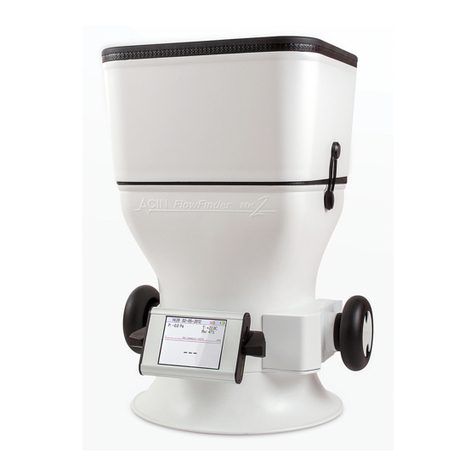
6
5.1 installatie van de micromanometer
• De micromanometer moet worden opgesteld op een stabiel en robuust (tafel)oppervlak.
Het is absoluut noodzakelijk om het instrument waterpas te plaatsen. Dit wordt gedaan door middel van
de 3 stelpootjes (13), gebruikmakend van de waterpas (3) bovenop
5.2 installatie van de koudlichtbron
• Zorg ervoor dat de netspanning voor de koudlichtbron correct is (zie 4. specificaties).
• Plaats het dunne eind van de lichtgeleider (11) in de achterkant van de micromanometer en fixeer dit
met met behulp van de vastzetschroef (10).
• Sluit het andere einde aan op de koudlichtbron. Schakel de koudlichtbron naar stand “1”.
5.3 vullen met meetvloeistof en installatie van de liniaal
• De meetvloeistof wordt geleverd in 1 fles van 1000 ml (model 250/2500) of twee flessen van 1000 ml
(model 500/5000).
• De glazen liniaal (6) met de glazen drijver (5) is verpakt in een liniaaldoos om breken tijdens het trans-
port te voorkomen. Wij raden u aan deze doos te bewaren voor toekomstig transport van het instrument.
• Verwijder de schroefring met (-) drukaansluiting van de stijgbuis (9).
• Draai de 4 schroeven van de drukring rondom de stijgbuis (9) los.
• Trek voorzichtig de stijgbuis met drukring omhoog en verwijder deze van het instrument.
• Vul de micromanometer mt de bijgeleverde meetvloeistof. Doe dit langzaam en voorzichtig, de vloeistof
heeft neiging tot schuimen.
• Inhoud vloeistofreservoir: ± 400 ml (model 250/2500), ± 1300 ml (model 500/5000)
• Neem de glazen liniaal (6) met drijver (5) uit de liniaaldoos door deze vast te houden aan de punt bo-
venop de glazen bol. Raak drijver en liniaal zelf niet aan, deze moeten schoon blijven.
• Houd de liniaal in vertikale positie vast bij de punt van de drijver, met de schaalverdeling op de liniaal
aan dezelfde kant als het projectiescherm (16), plaats de onderzijde van de liniaal in de liniaalgeleider
(8) en laat deze voorzichtig hierin zakken totdat de drijver rust op de liniaalopvang (7).
• Plaats de stijgbuis voorzichtig terug op de micromanometer en monteer de drukring weer met behulp
van de 4 schroeven. Gebruik geen vet, de O-ring onder de drukring moet schoon blijven.
• Draai de 4 schroeven kruislings beetje bij beetje aan totdat de stijgbuis weer stevig vastzit.
• Controleer het beeld van de liniaal dat nu op het scherm wordt geprojecteerd. Beeldscherpte en helder-
heid kunnen worden beïnvloed door verstellen van de lichtgeleider, na iets losdraaien van de vastzet-
schroef (10).
• Nu kan de nulstelling worden gecontroleerd. Het vloeistofniveau moet zodanig zijn dat de geprojec-
teerde nulstreep van de liniaal samenvalt met de nulstreep op het verstelbare projectiescherm (16), als
dit in de middenstand is gezet door middel van de nulstelschroef (1).
• Als er een negatieve aflezing is, is het vloeistofniveau te laag. Voeg wat vloeistof toe via de stijgbuis tot-
dat het instrument nul aanwijst. Laat de vloeistof langzaam en voorzichtig langs de binnenwand van de
stijgbuis lopen, om schuimvorming te voorkomen.
• Als er een positieve aflezing is, is het vloeistofniveau te hoog. Tap wat vloeistof af met behulp van de
vloeistofniveauregelaar (12) aan de achterzijde, totdat het instrument nul aanwijst.
• Fijninstelling kan worden gedaan met de nulstelschroef (1).
• Wacht minimaal 8 uur totdat het schuim in de vloeistof is verdwenen.
NB.
De nummers (..) refereren aan de tekening op pagina 3.
5. installatie
nederlands




























